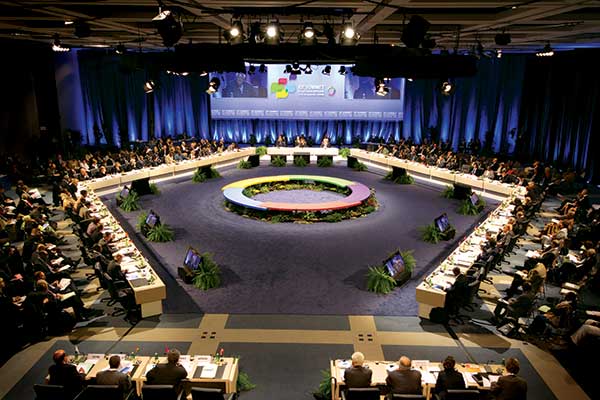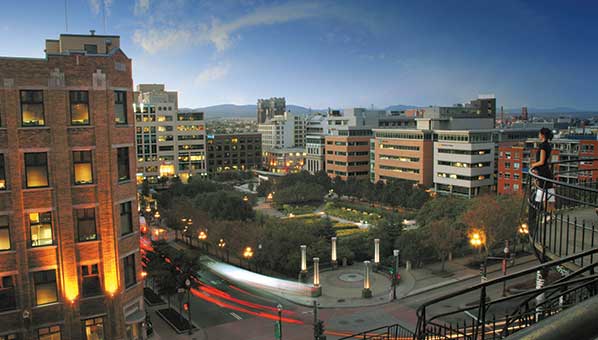
SPONSORED CONTENT
Content provided in collaboration with Québec City Business Destination
In today’s high-tech world, event planners around the globe are turning more and more to new technology solutions to streamline their event planning, decrease costs and enhance attendees’ overall experience. Yet with such an onslaught of new solutions and trends hitting the market every day, it can be a little overwhelming trying to distinguish the hype from the true innovations that can really help you with your next event—without breaking the bank.
Recognized for his forward-thinking in offering high-tech solutions for event planners, Philippe Dupont, account manager for Freeman Audio Visual Canada, official AV partner of the Québec City Convention Centre, shares his top four tips to effectively and affordably incorporate new technology in an event.
1. Consider a new twist on the KISS principle
As most event planners know, there is still a lot of buzz around attendee engagement. With attendees more hyper-connected than ever before, attention spans are becoming shorter, making it harder to keep participants involved in events. “I recommend rethinking the standard 9-5 conference or meeting format,” says Dupont. “We are dealing with a new generation of event goers who don’t want to sit through four hours of traditional speeches or spend hours walking through a standard exhibit. We’re seeing more and more planners designing events like the ever-popular TED conferences, investing in short video presentations, and adding interactive content and presentations to the mix. It’s really a new twist on the KISS principle: Keep it succinct and sexy.”
In other words, you need to tap into what makes your attendees tick, and brainstorm new conference or meeting formats to keep them engaged. “It doesn’t have to be complicated,” he adds. “The best advice I can give is talk to your audiovisual supplier and dedicated marketing teams so that they recommend accessible options that don’t require months and months of development or overhauling your entire event plan.”

Québec City Convention Centre by SCCQ
Invest in immersive experiences
2. Invest in immersive experiences
“Now a lot of people hear the words ‘gesture and motion control’ and automatically think of expensive technology from a sci-fi film,” notes Dupont. Gesture control enables attendees or conference speakers to interact with an object, say, a product that is not necessarily physically available. “However, it is important to remember that there are a lot of new technology solutions out there that are actually affordable and accessible to event planners.” It is crucial that event planners carefully map out their budgets. “Planners may be surprised to discover that the cost of implementing motion control in their exhibit booth, so that visitors can touch and manipulate a product, for example, is much less than actually shipping a product to a location,” Dupont explains. “This is particularly true for products that are cumbersome, risky or expensive to ship, such as vehicles.”
3. Leverage technology to gather data
Event planners are increasingly requiring more holistic and granular attendee data for their post-event reports and are using more accurate profiling to win over sponsors with the help of technologies such as radio-frequency identification (RFID) and near field communication (NFC).
“RFID/NFC go beyond the typical exchange of business cards and badge scans,” says Dupont. “We’re seeing these technologies used to pinpoint user behavior.” For example, when event organisers use RFID/NFC bracelets in exhibits, they can know exactly where a specific attendee went, what booths were visited and how long he or she stayed with one exhibitor. “Now that’s intelligence,” he adds. “I recommend that event planners verify with venues to see if the technology is offered. If so, they can even find out the venue’s hot spots to better select spaces within the venue for heightened attendee traffic.”

Jardin de Saint-Roch by Marie-Chantal Le Breton
Broaden your definition of connectivity
4. Broaden your definition of connectivity
Connectivity goes beyond “simply” having a reliable Wi-Fi connection. An event’s connectivity is also defined by how it reaches out to attendees who are physically on site and those who are participating virtually.
It stands to reason that an event needs to offer Wi-Fi for the busy, connected business traveller. When scouting out hotels and venues, be sure to ask about how pervasive their Wi-Fi connections are. For example, Hôtel Delta Québec and Hilton Québec in Québec City both offer free Wi-Fi in many areas. And the Québec City Convention Centre is the first of its kind in Canada to offer high-speed Wi-Fi throughout its entire facility.
Event planners are adding a virtual component to live events. “We’re increasingly seeing planners adding webcasting and virtual exhibits—particularly to reach out to people who cannot attend,” mentions Dupont. “And social media and live blogging are really taking off to keep attendees interested and start conversations on a larger scale than we could ever have accomplished in the past.” Planners are also increasingly exploring ways to get event goers—not just virtual attendees—to participate in conversations on social media, particularly using hashtags, to get topics and news items trending.
Event mobile apps, often offered in conjunction with venues and partners, such as those with the Québec City Convention Centre and Freeman Audio Visual Canada, can be great investments. As Dupont points out, “mobile apps help reduce material and paper costs as well as provide a greener option for event planners. The trick is to determine your app strategy in advance to cut cost and find the most suitable developer.”
Without a doubt, technology solutions will continue to evolve as well as play a more integral role in event planning. “The best advice I can give? The technology aspect should be one of the first things planners consider. That way, they can more effectively align their technology strategy with their budgets,” he concludes. “With a bit of foresight and ingenuity, technological innovation is truly accessible to all.”



